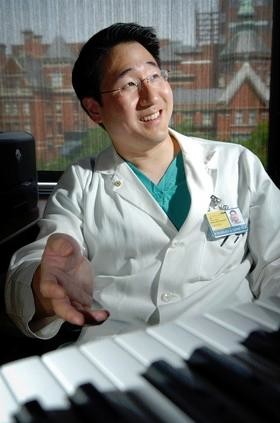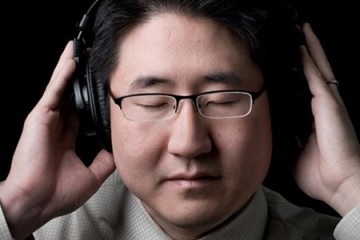This article is part of the Provost's Project on Innovation series

"I'm just obsessed with sound," Charles Limb, M.D., readily acknowledges. "I am thoroughly, deeply, extraordinarily immersed in music at a level where I can't stop thinking about it. That single-mindedness has fueled a lot of what I do in my life, including my decision not to be a musician."
So what, then, does this music-obsessed nonmusician do with that passion? He becomes a physician, of course and, over time, combines music and medicine in his search to discover the source of innovation.
As a young saxophonist, Limb listened intently to the likes of John Coltrane and Sonny Rollins, "the musicians that transformed jazz," and concluded, "I am never going to come even remotely close to changing music the way they have." So, "without angst," he became a hearing specialist, an otolaryngologist who, in part, initiates or restores hearing through cochlear implants. He admits that "the technology and our understanding of music perception—cognitively, neurologically, audiologically—is still relatively crude."
His work, however, has become broadly philosophical. He asks: How do creativity and innovation occur? Where does brilliance come from? Where do we get creative insight? What is the neural mechanism, the neurobiology of that process? Can we intervene to make more circuitry available for creativity?
In his pursuit of answers, he has taken a tack that is itself innovative. With collaborator Allen Braun at the National Institutes of Health, Limb uses functional magnetic resonance imaging, fMRI, to study which areas of the brain activate when accomplished jazz musicians play a memorized piece and then improvise on it. In the cramped fMRI tube, accommodating jazz artists play on a truncated, nonmagnetic keyboard that rests on their legs while mirrors provide a view of the instrument. After completing the memorized piece, they improvise while their brain function is being recorded, enabling Limb to examine what takes place in the musicians' brains as they play creatively. At Johns Hopkins, Limb has extended these studies to freestyle rap in hip-hop rappers and also to the process by which musicians "trade fours," that is, alternate playing four bars in a musical conversation with Limb, who plays on another keyboard outside the imaging machine.
"I'm taking musicians at the highest levels of their craft and trying to capture what they do," he says. "It's almost like trying to capture lightning in a bottle." The highly skilled artists are so good at what they do that they can perform even under these unusual circumstances. "The more trained you are," Limb says, "the more resources, neurologically speaking, you can devote to conceiving and executing something creative."
His research found that certain areas of the brain, including regions involved with the senses, are activated during improvisation, producing a true state of heightened awareness. Trained musicians hear music almost like a second language. The brain patterns during improvisation also resemble those observed during REM sleep, the state of dreaming.
Equally fascinating, certain brain regions are shut down. "In every experiment I've done where there is some sort of what we call a 'flow state'—such as jazz improvisation or freestyle rap, where an artist is generating a lot of information on the fly, spontaneously—there appear to be important areas of the prefrontal cortex that are turning off, or relatively deactivating," Limb says. "The interesting thing here is that the brain is selectively modulating itself to promote novel ideas and to prevent over-self-monitoring and inhibition of one's impulses."
This type of intellectual inquiry was not always in Limb's plan. Although he did not expect to stay in Baltimore beyond his surgical training, now he cannot imagine leaving. "I don't think that I can do what I do in any other university or medical center in the world," he says. "It's unusual to find a high-level hospital that also has a high-level conservatory—but beyond that, has people in place who support the idea of something interdisciplinary between those two worlds."
While grateful for the support he has received at Johns Hopkins, Limb is frustrated that his area of scientific research attracts little external funding. With some exasperation, he describes being told recently by the NIH—as they rejected a grant application without review—that "creativity doesn't fit under the mission of NIH." How did Limb respond? "I don't think human society can survive without creativity," he asserted. "Are you really sure it doesn't fit under your mission statement?"
Limb believes that "artists are much closer to the truth" than are scientists. In his view, the subject of creativity is too important to ignore, and he will continue to explore innovation through his two passions. "To me," he says, "both music and medicine deal with life at its core.... They're both there to define the essential human condition, to help us understand what it means to be human."
Just as technology enables him to map the creative brain, it is also sparking wider interest in his ideas. "If I publish a scientific paper in a traditional journal," he says, "I'm lucky if 40 or 50 people read it—but the paper on creativity that I published in 2008 using an open access platform has been downloaded online more than 35,000 times, while the first TED talk that I gave on improvisation has been viewed well over half a million times."
Ultimately, he says, "what I hope happens is that—in the aggregate over many years, and with the combined efforts of many labs—the neuroscience of creativity will become established as a viable field of study." That is probable, if not inevitable. Like laying down an appealing jazz track for others to follow, Charles Limb is creating a riff that resonates.
Posted in Health, Arts+Culture, Science+Technology
Tagged music, neuroscience, charles limb








